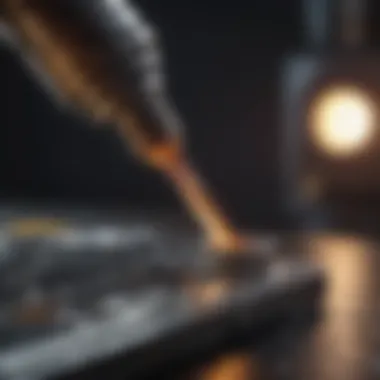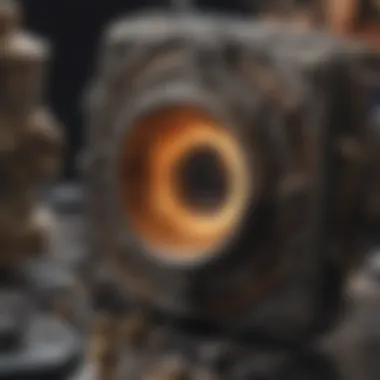Unveiling the Mastery of Soldering with a Torch: A Comprehensive Guide


Overview of Soldering with a Torch
Soldering with a torch is a meticulous craft that demands precision and finesse. This process involves joining metal components using a torch to melt solder, creating a strong and lasting bond. Whether you are a novice artisan or an experienced jewelry maker, understanding the intricacies of soldering with a torch can elevate your craftsmanship to new levels.
When delving into the art of soldering with a torch, you delve into a world where mastery of technique, equipment, safety precautions, and best practices are paramount. This guide aims to equip you with the essential knowledge and skills required to excel in the realm of torch soldering.
Torch Soldering Techniques
Soldering with a torch encompasses various techniques that cater to different project requirements and material specifications. From sweat soldering to chip soldering, each technique offers unique advantages and challenges that can be mastered with practice and dedication.
Sweat Soldering
Sweat soldering involves carefully positioning solder between metal joints and using a torch to melt the solder, allowing it to flow and create a seamless bond. This technique is ideal for joining flat surfaces and delicate connections where precision is crucial.
Chip Soldering
Chip soldering, on the other hand, requires melting small chips or pieces of solder directly onto the metal surfaces to be joined. This technique is commonly used for intricate designs and repairs, offering greater control over the solder placement and flow.
Essential Equipment for Torch Soldering
Torch Selection
When it comes to torch selection, factors such as flame size, fuel type, and adjustability are critical considerations. Whether you opt for a butane torch for precise work or an oxy-acetylene torch for high-temperature applications, choosing the right torch can significantly impact the quality and efficiency of your soldering projects.
Solder and Flux
Selecting the appropriate solder and flux is essential for achieving strong and durable solder joints. Different solder alloys offer varying melting temperatures and properties, catering to a wide range of metal types and project requirements. Additionally, flux serves as a cleaning agent and helps facilitate the flow of solder, ensuring proper adhesion and cohesion between metal components.
Safety Measures in Torch Soldering


Safety is paramount in torch soldering, where the use of open flames and hot metal components poses risks of burns, fires, and exposure to harmful fumes. Prioritizing safety measures and adhering to best practices is crucial to safeguard yourself and your workspace during soldering operations.
Protective Gear
Wearing appropriate protective gear, such as heat-resistant gloves, safety goggles, and a protective apron, is essential to shield yourself from potential hazards. Additionally, ensuring proper ventilation in your workspace can help dissipate fumes and maintain a safe soldering environment.
Fire Safety
Having fire extinguishing equipment, such as a fire extinguisher or fire blanket, within reach is imperative to address any unexpected fire incidents promptly. Moreover, keeping a clean and organized work area can prevent accidental fires and enhance overall workplace safety.
Introduction
Highlighting the significance of the Introduction section within this article is crucial, as it sets the foundation for understanding the nuanced art of soldering with a torch. By delving into the basics of soldering, readers, especially gemstone enthusiasts, collectors, and jewelry designers, can grasp the fundamental principles behind this technique. From comprehending the intricacies of different solder types to mastering the usage of flux, each aspect covered in the Introduction lays the groundwork for a comprehensive exploration of soldering techniques.
Moreover, for those venturing into the realm of soldering for the first time, this section serves as a gateway to comprehending the importance of each component involved in the soldering process. The Introduction acts as a beacon, guiding novices through the initial steps of selecting the right torch, understanding the differences between a soldering iron and torch, and making informed decisions to kickstart their soldering journey. By focusing on pivotal elements of soldering such as heat distribution, flame control, and proper soldering positions, readers can gain a holistic understanding of the meticulous art of soldering.
Understanding Soldering
What is Soldering?
Soldering is a precise method of joining metals using a filler material known as solder, typically a metal alloy with a lower melting point than the workpiece. This process creates a strong, permanent bond between the pieces being soldered. Understanding the principles behind soldering is essential for achieving clean and durable connections in various crafting projects.
Types of Solder
There are several types of solder available, each suited for specific applications based on their composition and melting points. Common types include tin-lead solder, lead-free solder, silver solder, and flux-core solder. Knowledge of the different solder types is paramount in choosing the right material for the desired outcome and ensuring successful solder joints.
Importance of Flux
Flux is a chemical cleaning agent used in soldering to prevent oxidation and facilitate the flow of solder. Its role in the soldering process is crucial as it removes surface oxides from the metals being joined, promoting better wetting and adhesion. Understanding the significance of flux and its proper application is key to achieving high-quality, professional soldered connections.


Essential Equipment
In the realm of soldering with a torch, the significance of having the right essential equipment cannot be overstated. The choice of equipment directly influences the precision, quality, and efficiency of the soldering process. Essential equipment includes torches, flux, solder, heat-resistant surfaces, and safety gear such as goggles and heat-resistant gloves. Each component plays a crucial role in ensuring seamless soldering operations. Torch types vary in size, fuel source, flame temperature, and special features, offering flexibility for different soldering projects. Soldering iron vs. torch presents a common dilemma among craftsmen. While a soldering iron offers precision for delicate work, a torch provides higher heat output for larger projects. Choosing the right torch involves factors like project size, required heat intensity, fuel type preference, and budget constraints. Selecting a torch that aligns with your soldering needs is essential for achieving optimal results and enhancing workmanship quality.
Safety Measures
Soldering with a torch involves inherent risks that necessitate strict adherence to safety measures to ensure a secure working environment. Prioritizing safety not only safeguards the artisan but also enhances the overall soldering experience. Proper implementation of safety protocols minimizes the chances of accidents and promotes efficiency in the crafting process. Ventilation, protective gear, and fire safety comprise the trifecta of crucial safety measures imperative for successful torch soldering.
Ventilation
An often overlooked yet critical aspect of torch soldering, ventilation plays a paramount role in dispersing potentially harmful fumes and gases. Adequate ventilation is essential to prevent the inhalation of noxious substances released during the soldering process. Proper airflow helps maintain a breathable atmosphere, safeguarding respiratory health. Positioning the workspace near a window or utilizing fume extractors ensures efficient air circulation, reducing the risk of exposure to harmful emissions during soldering.
Protective Gear
Embracing the use of appropriate protective gear is non-negotiable when engaging in torch soldering. Shielding oneself from potential hazards such as burns, splatters, and fumes is indispensable for a safe soldering experience. Soldering goggles or a face shield protect the eyes from intense light and potential splashes of molten metal. Heat-resistant gloves safeguard the hands from burns, while a durable apron shields clothing from soldering debris. Wearing closed-toe shoes further minimizes the risk of accidental injury during the soldering process.
Fire Safety
Flame management is central to torch soldering and requires a thorough understanding of fire safety principles. Implementing fire safety measures not only prevents accidental fires but also mitigates the risk of burns or property damage. Keeping a fire extinguisher within reach is imperative for immediate response to any untoward incidents. Maintaining a clutter-free workspace devoid of flammable materials minimizes fire hazards. Prioritizing situational awareness and employing safe soldering techniques diminishes the likelihood of fire-related accidents, ensuring a controlled and secure soldering environment.
Techniques and Tips
Soldering with a torch requires precision and skill to achieve impeccable results. In this section, we will delve into the essential techniques and valuable tips that can elevate your soldering craftsmanship. Mastering these aspects will not only enhance the quality of your work but also streamline your soldering process, making it more efficient and effective. Understanding the nuances of flame control, heat distribution, and proper soldering position is crucial for producing flawless solder joints.
Flame Control
Achieving the ideal flame for soldering is fundamental to the success of your projects. Proper flame control involves adjusting the torch to produce a steady, even flame without fluctuations. By maintaining a consistent flame, you can control the heat application during soldering, preventing overheating and ensuring precise bonding of metals. The size and intensity of the flame play a significant role in determining the solder flow and joint strength.
Heat Distribution


Even heat distribution is key to achieving uniform solder joints and preventing overheating or cold spots. Properly heating the entire workpiece ensures that the solder flows smoothly and bonds effectively to the metals being joined. Uneven heating can lead to weak joints or insufficient solder coverage, compromising the integrity of the connection. Mastering heat distribution requires practice and attention to detail, adjusting the torch angle and distance to evenly heat the workpiece.
Proper Soldering Position
Positioning plays a critical role in soldering success, affecting the flow of solder and the overall quality of the joint. Maintaining the correct angle and proximity of the torch to the workpiece is essential for precise soldering. A steady hand and consistent soldering position help control the application of heat and the direction of solder flow, ensuring clean and durable solder joints. Proper soldering position minimizes the risk of overheating or incomplete bonding, resulting in professional and reliable soldered connections.
Common Mistakes to Avoid
In the realm of soldering with a torch, being mindful of common mistakes is paramount to achieving successful outcomes. By highlighting and understanding these pitfalls, artisans can elevate their craftsmanship to unparalleled levels. One crucial aspect to consider is the detrimental effect of overheating during the soldering process. This common misstep can lead to material damage, weakening of joints, and overall unsatisfactory results. By diligently monitoring the temperature and adjusting flame control, practitioners can avoid the perils associated with overheating, ensuring precise and immaculate soldering work.
Another common mistake that aspiring jewelers must steer clear of is the usage of insufficient flux. Insufficient flux hinders the solder's ability to flow smoothly, resulting in weak bonds and unreliable connections. A judicious application of flux is vital to facilitating the soldering process, promoting effective bonding between metal surfaces. By grasping the significance of flux and applying it generously, craftsmen can enhance the quality and durability of their soldered creations with finesse.
Furthermore, rushing the soldering process is a cardinal sin that can compromise the integrity of the final outcome. Impatience often leads to uneven heating, inadequate joint formation, and overall shoddy workmanship. Taking the time to heat the workpiece evenly, position it correctly, and allow the solder to flow naturally is indispensable for achieving seamless solder joints. By exercising patience and precision, artisans can circumvent the pitfall of rushing, ensuring meticulous execution and superior quality in their soldering projects.
Troubleshooting
Cold Joints
Cold joints are a common challenge in soldering that can compromise the integrity of your work. When two metal pieces fail to fuse properly, a cold joint is formed, weakening the overall structure. To avoid cold joints, it is essential to ensure proper heat distribution and sufficient solder flow. By applying adequate heat to the joint and allowing the solder to melt fully, you can prevent cold joints and create strong, durable connections. Additionally, optimizing your torch's flame control and soldering position can enhance joint quality and mitigate cold joint formation.
Soot Build-Up
Soot build-up during soldering can be a nuisance, affecting the cleanliness and aesthetics of your workpiece. Excessive soot is often the result of inefficient fuel combustion, leading to the formation of carbon residues on the soldered area. To mitigate soot build-up, optimize your torch's fuel-to-air ratio for clean, efficient combustion. Proper ventilation in your workspace is also crucial to dissipate soot particles and maintain a clear soldering environment. By monitoring and adjusting your torch settings, you can minimize soot accumulation and achieve pristine soldering outcomes.
Solder Balling
Solder balling is another common issue that can occur during soldering with a torch, impacting the overall quality of your joints. When solder forms into small balls instead of flowing smoothly, it can result in uneven or weak connections. To prevent solder balling, it is vital to regulate the temperature and solder application effectively. Ensuring proper flux application and optimizing your torch's heat control are key factors in preventing solder ball formation. By practicing precise soldering techniques and monitoring the solder flow, you can avoid solder balling and achieve flawless soldering results.
Conclusion
One of the fundamental aspects emphasized throughout this guide is the significance of patience in the soldering process. From controlling the flame to distributing heat appropriately and ensuring the soldering position is correct, each step requires a steady hand and a focused mind. Moreover, the emphasis on safety measures such as maintaining proper ventilation, donning protective gear, and practicing fire safety protocols underscores the meticulous approach required in soldering with a torch.
Furthermore, the articulation of common mistakes to avoid, including overheating, insufficient flux application, and rushing through the process, sheds light on the nuances that can make or break a soldering project. By highlighting these pitfalls and offering insightful tips for troubleshooting issues like cold joints, soot build-up, and solder balling, this guide equips both novice jewelry makers and seasoned artisans with the expertise needed to navigate challenges in their soldering endeavors.
In synthesizing the information presented in this detailed discourse on mastering soldering with a torch, it becomes apparent that this guide transcends mere instruction; it serves as a roadmap towards excellence in craftsmanship. By encapsulating essential techniques, equipment considerations, safety protocols, common mistakes, and troubleshooting insights, this article aims to empower the readers -- whether gemstone enthusiasts, collectors, jewelry designers, or geology buffs -- to elevate their soldering skills to new heights, fostering a deeper appreciation for the art of soldering in the realm of jewelry making and craftsmanship.







